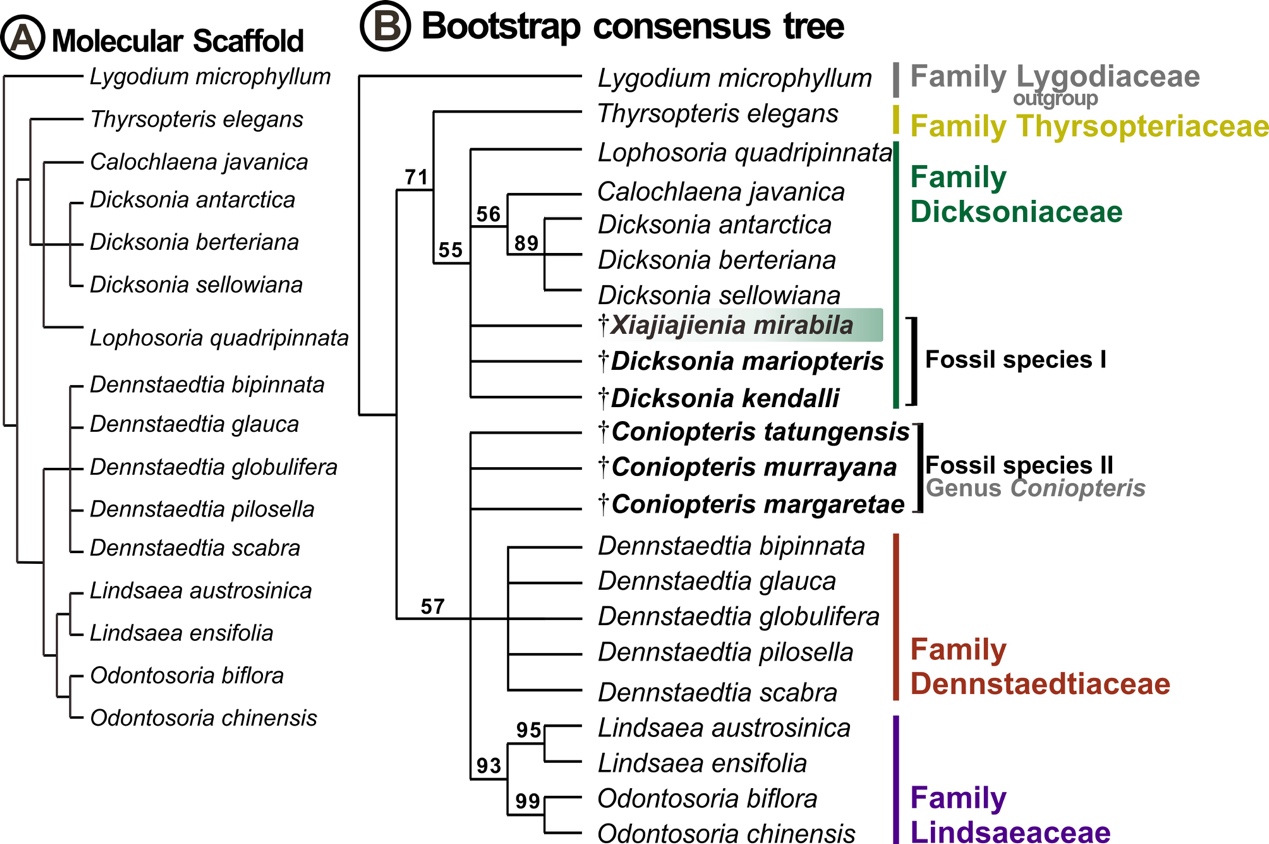The family Dicksoniaceae, one of the most important floristic elements of the Mesozoic, had two flourishing periods which is in the Middle Jurassic and the Early Cretaceous. Although there are still arguments about the classification of some taxa, fossil genera that yield cup-shaped or bivalvate indusia in sori have been considered members of the family Dicksoniaceae.
Xiajiajienia Sun, Zheng, and Mei is a unique fossil taxon within the fern family Dicksoniaceae. It was originally described by Professor SUN Ge et al. on the basis of fossils discovered in Xiajiajie, Jilin and Huangbanjigou, Liaoning provinces, leading to the establishment of a new genus. In recent years there have been few reports on Xiajiajienia due to the lack of fossil specimens. Some of the sterile organs of the fossil specimens have been assigned to Cycadophyte, specifically as part of the genus Rehezamites by Pott, McLoughlin, Lindstrom, Wu and Friis.
Led by Professor WANG Yongdong of the Nanjing Institute of Geology and Palaeontology, Chinese Academy of Sciences (NIGPAS), an international team recently conducted a systematic investigation on newly discovered material of the Xiajiajienia mirabila from the Jehol biota in wetsrn Liaoning Province. The research team revised the taxonomic characteristics of Xiajiajienia based on morphological features and discussed its potential taxonomic position within the Dicksoniaceae from a phylogenetic perspective. The results of this study have recently been published in the international peer-reviewed journal Cretaceous Research.
The genus Xiajiajienia has marginal borne sori with bivalvate indusia in the fertile pinnule which were consistent with the diagnosis of Dicksoniaceae; but has unlobed drepaniform sterile pinnules, which were distinguishable from other genera in Dicksoniaceae.
The newly found fossil specimen of Xiajiajienia was preserved as the impression with counterpart, and was collected from Huangbanjigou of Jianshangou Bed of the Jehol Biota, with fine preservation of delicate structures of sterile and fertile pinnules. The specimens provide the evidence of a "partially fertile pinna" that existed in Xiajiajienia. Fertile segments are slightly contracted and reduced. Sori are marginally borne, with distinct bivalvate indusia. Sterile pinnules are unlobed, drepaniform to long tongue-shaped, strongly decurrent.
Based on the characteristics of the fertile pinnules, the research team discussed the phylogenetic position of Xiajiajienia using phylogenetic analysis methods combined with the constraints of the Molecular Scaffold of modern ferns and assessed its relationship to Dicksoniaceae, Dennstaedtiaceae, Lindsaeaceae, as well as other ferns with similar morphological characteristics of sorus. The results show that Xiajiajienia is more closely related to the Dicksoniaceae, and some fossil species of the genus Dicksonia L'Héritier than to the common Mesozoic fern Coniopteris Brongniart.
In addition, based on the palaeoclimate reconstructions of the Jehol Biota in previous studies, the research team hypothesized that the growth environment preference of Xiajiajienia was a mild climate with seasonal variations, similar to that of certain modern Dicksonia species, with some regional moisture requirements.
This work is jointly funded by the National Natural Science Foundation of China , the Strategic Priority Research Program (B) of the Chinese Academy of Sciences , the State Key Laboratory of Palaeobiology and Stratigraphy, the ICDP Integrated Understanding of the Early Jurassic Earth System and Timescale (JET) projects (IGCP 632, IGCP 655 and IGCP 739), and the China Scholarship Council.
Reference: ZHANG, L., WANG, Y., RUHL, M., ZHU, Y. and LI, H. 2023. Re-investigations of the fossil fern Xiajiajienia mirabila (Dicksoniaceae) based on new material from the Lower Cretaceous of western Liaoning, China. Cretaceous Research, 149, 105543. https://doi.org/10.1016/j.cretres.2023.105543.

Figure 1. Three types of pinnae of Xiajiajienia mirabila, partly fertile pinna (A-B), sterile pinna (C), and fertile pinna (D), all at a scale of 1 cm; subfigs. E, F, and G are partial enlargements of the sterile pinna of Figs. A, B, and C, respectively, showing their drepaniform and unlobed morphology, at scales of 2 mm, 2 mm, and 5 mm, respectively.

Figure 2. Fertile pinnules and sori comparisons between Xiajiajienia mirabila and modern Dicksonia (D.lanata), showing characteristics of marginal borne sori with bivalvate indusia in the fertile pinnule.

Figure 3. Sketch reconstructions of Xiajiajienia mirabila. A, the sterile pinna; B, the sterile pinnules; C, sorus, spore, and possible sporangium; D, fertile pinna (fully); and E, fertile pinna (partly).

Figure 4. Majority-rule consensus tree of Xiajiajienia and its related groups by a cladistic analysis of reproductive structure characters.
Contact:
LIU Yun, Propagandist
Email: yunliu@nigpas.ac.cn
Nanjing Institute of Geology and Palaeontology, Chinese Academy of Sciences
Nanjing, Jiangsu 210008, China
Download:
